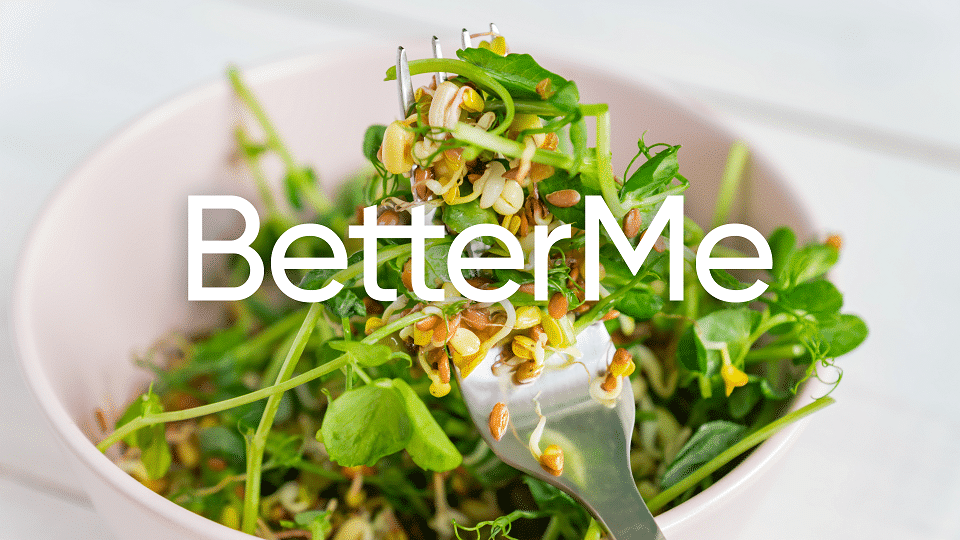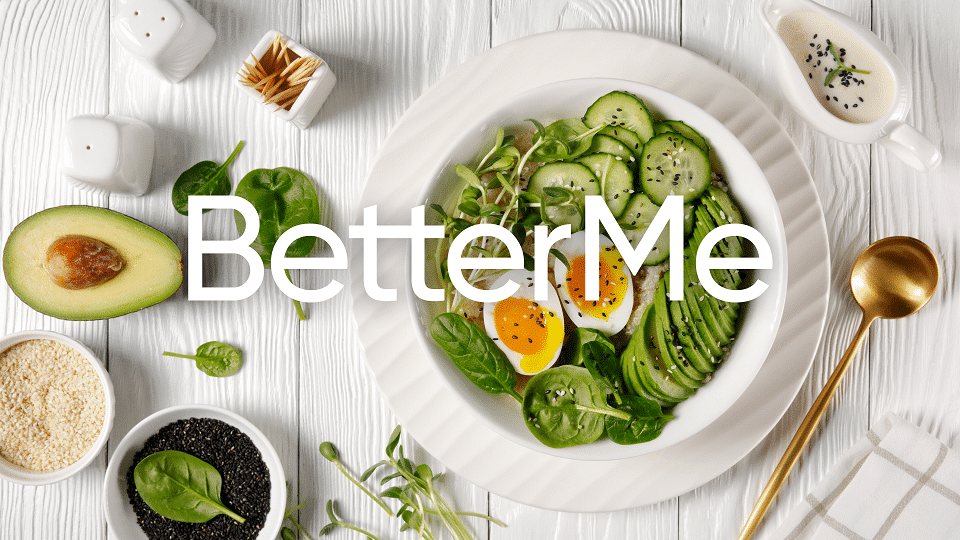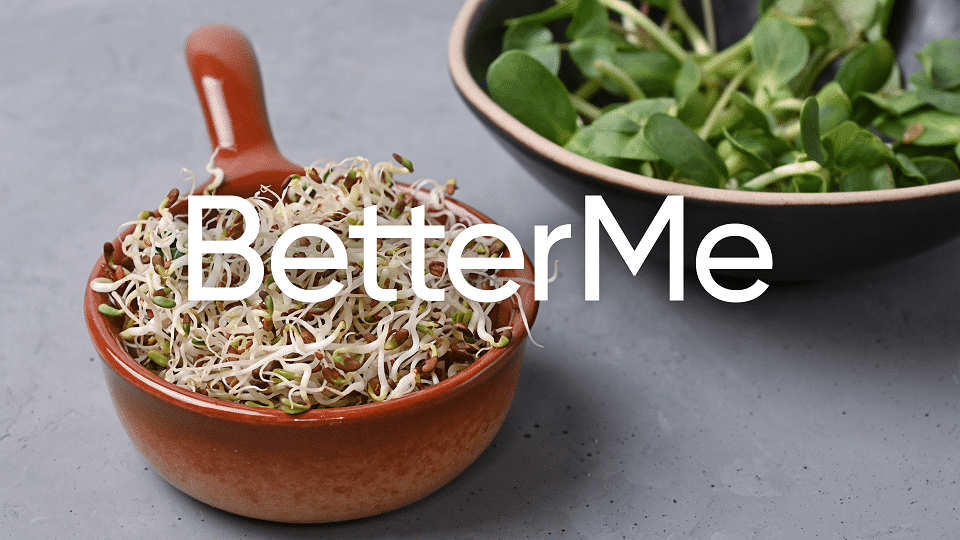Microgreens are an emerging type of specialty vegetable that people can buy from shops and grow at home from the seeds of vegetables, herbs, or grains. Sunflower microgreens are most often grown from black oil sunflower seeds. The microgreens are harvested when the green leaves have just started to sprout, before they are 1-2 weeks old. Sunflower shoots are sunflower seedlings that take between 7 to 12 days to grow. They are harvested before or right after the first true leaves form. Sunflower microgreens can be eaten like sprouts in salads, sandwiches, and wraps. In this article, we’ll look at the sunflower microgreens nutrition chart, as well as their health benefits and possible side effects. We’ll also describe how to grow and harvest them.
Get your personalized
meal plan!
Nutrition Data: What’s Inside Sunflower Microgreens?
Sunflower microgreens contain a rich supply of vitamins and minerals, with some varieties containing more than the adult equivalent of their respective mature vegetables.
According to USDA’s sunflower microgreens nutrition data, a 64 g serving of sunflower microgreens will provide (7):
- 25 calories
- 2 g of protein
- 4 g of carbohydrate
- 2 g of fiber
- 80 milligrams (mg) of calcium
- 14.4 mg of iron
- 60 mg of magnesium
- 80 mg of phosphorus
- 270 mg of potassium
- 10 mg of sodium
- 0.6 mg of zinc
- 9 mg of vitamin C
- 40 micrograms (mcg) of vitamin K
- 60 mcg of folate
- 500 IU of vitamin A
The greens also contain selenium, manganese, and a range of B vitamins.
Read More: Escarole Benefits: How To Use This Italian Vegetable For Better Health
Health Benefits Of Sunflower Microgreens
Let’s look at sunflower microgreens benefits according to their nutritional profile:
Contains Disease Fighting Antioxidants
Sunflower microgreens several nutrients which work as powerful antioxidants that protect cell membranes and other structures in the body from damage by free radicals.This may help reduce or prevent some of the effects of aging such as heart disease, cancer, and arthritis.
Good For Your Heart
Cardiovascular disease is a term used to describe diseases of the heart and blood vessels. Sunflower microgreens, like many plant foods, contain phytosterols, which are plant compounds that may help protect the heart by lowering cholesterol (9).
Good For Your Eyes
Sunflower microgreens are a rich source of vitamin A, a nutrient that is essential for normal vision. Vitamin A also helps protect the cells in the body from free-radical damage and keeps the immune system healthy (17).
Aids In Weight Loss
Sunflower greens contain a good amount of fiber and protein. As part of a healthy, balanced diet, these vegetables can help control hunger and reduce calorie intake. Fiber also helps regulate blood sugar levels by slowing down carbohydrate digestion (14).
May Reduce Menopausal Symptoms
Sunflower microgreens are high in calcium, which is needed for muscle contractions, blood vessel contraction and expansion, hormone secretion, and normal heart rhythm. Getting enough calcium can also help prevent bone loss in peri- and postmenopausal women (16).
May Improve Digestion
Sunflower greens contain dietary fiber and protein, which can improve digestive health by slowing down the movement of food through the intestines and making you feel full for a longer period of time after eating. Fiber also helps facilitate regular bowel movements and promotes the growth of beneficial bacteria in the digestive system.
Good For Bone Health
Sunflower microgreens are rich in calcium, which is necessary for bone development and strength. Magnesium deficiency can also result in osteoporosis or brittle bones. Sunflower microgreens also contain a number of other nutrients that are important for bone health, including vitamin K, manganese, potassium, phosphorus, copper, and zinc (4).
If you wish to free yourself from all the extra pounds that have been weighting you down for way too long, start using the BetterMe app and overhaul your entire life!
Contains Essential Amino Acids
Sunflower microgreens are rich in 8 of the 9 essential amino acids which you need to obtain from food in order to build and maintain body tissues, and facilitate metabolic reactions, among other essential roles in the body (11).
Good For Muscle Function
Sunflower microgreens contain potassium and magnesium. Potassium is the major mineral found inside cells and magnesium is important for muscle function as well as the function of other organs in the body (6).
Supports Immune System
Sunflower microgreens are rich in vitamin C, which is needed for making collagen and absorbing non-heme iron. It is also an antioxidant and plays an important role in immune system function by preventing infections and strengthening the immune cells that fight illness (18).
Good For Skin Health
Sunflower microgreens are a great source of vitamin C, which is necessary for the growth and repair of tissues in all parts of your body. Vitamin C also helps promote healthy skin by supporting formation of collagen. It also provides antioxidant protection from free radical damage to cells (18).
Other nutrients in these greens that nourish your skin are (18):
- Vitamin A: Combats dry skin, redness and acne. Improves the appearance of aging skin by increasing collagen production. Helps reduce inflammation in the body, which can contribute to acne.
- Vitamin E: Prevents signs of aging, protects against sun damage, fights off free radicals that can cause cancer.
- Zinc: Helps the body form new cells, which is necessary for wound healing. Keeps nails, hair and skin healthy.
- Selenium: Deficiencies can lead to acne and blotchy skin because it prevents inflammation in the skin. It is also a powerful antioxidant that can help fight free radicals and prevent cell damage.
- Carotenoids: Prevents cancer and enhances immune system function.
May Reduce Symptoms Of Allergies
Sunflower greens are rich in manganese, which is necessary for metabolizing fats and proteins (5). It can also stimulate the production of enzymes that break down histamine, possibly helping to reduce allergy symptoms (13).
Good For Pregnant Women
Sunflower greens are rich in folate. Folate deficiency is associated with birth defects, so it is important for all women of childbearing age to get enough folate or folic acid. It is also necessary for DNA synthesis and the formation of red blood cells (1). Sunflower microgreens are a great source because they contain more folate than most other greens.
Read More: Purple Cabbage Benefits: 7 Reasons Why This Colorful Veggie Should Be On Your Plate
How To Grow Sunflower Microgreens
Microgreens are easy to grow, they can thrive indoors where sunlight is available. There are three steps to growing microgreens:
Scatter The Seeds
First, scatter sunflower seeds on top of moistened potting soil. The seeds should be placed about one inch apart so they grow into full-sized plants.
Water The Seeds
Sprinkle water over the top to soak the soil. Be careful not to over-water, as the soil should be moist, not drenched. If you find that you tend to water too much, consider growing microgreens in a tray on a windowsill so they can dry out between waterings.
Provide Sunlight
Give the sunflower seeds plenty of sunlight. Put them under a grow light or on a windowsill that gets at least six hours of sun every day. Sunlight is necessary for the plants to photosynthesize and produce their own food through a process called chlorophyll synthesis. If they do not get enough sunlight, they will die.
Once the plants are about four inches tall, you can harvest them.
Harvest Sunflower Microgreens
Sunflower microgreens can be harvested once they have developed their first set of true leaves (the leaves that sprout directly out of the soil). The shoot should be at least 1″ tall. They are best eaten fresh, but if you need to store them, you can cut the shoots off at the base and place them in a glass of water. They should store well for up to five days.
Side Effects Of Eating Sunflower Microgreens
Sunflower seeds are generally safe, but experts have raised concerns over the risks of allergies and contamination.
Allergies
People allergic to sunflower seed proteins may experience dangerous reactions when they consume sunflower greens. Symptoms include (12):
- Burning in the mouth and throat
- Swelling of the tongue and throat
- Lightheadedness
- Wheezing or difficulty breathing
If you have these symptoms after eating microgreens, call 911 or go to a nearby emergency room without delay.
Sunflower Greens Contamination Risks
Sunflower greens often come into contact with soil and dirt, so there is a risk of contamination from mold or bacteria.
One bacteria you may get from consuming sunflower microgreens is Escherichia coli. This is a bacterium that produces Shiga toxin, which attacks the lining of the small intestine. Symptoms include abdominal cramping and watery diarrhea (2).
The risk of contamination is higher for sunflower greens grown in certain soils. Experts advise that you rinse microgreens thoroughly before eating them to reduce the risk of contamination, illness, and allergic reaction.
Yanking yourself back in shape has never been so easy with our game-changing fitness app! Start transforming your life with BetterMe!
How To Eat Sunflower Microgreens
There are many ways to use sunflower microgreens. Here are some of the most common uses:
Salad Toppings
Cut off the top inch or two of microgreens, including their stems. Rinse them thoroughly under running water. Pat them dry with a clean towel or paper towels, then chop them coarsely. Sprinkle them over salads to add flavor, nutrition, and crunch.
Sandwiches
Microgreens are a great addition to sandwiches because their intense flavor enhances the other ingredients. Cut off the top inch or two of microgreens, including the stems. Rinse them thoroughly under running water. Pat them dry with a clean towel or paper towels, then cut them into thin strips. Sprinkle them over sandwiches for an extra boost of flavor and nutrition.
Snacks
Eat microgreens as a healthy alternative to chips at movie night, during sports games, or while watching a TV show. Since they are a little bitter, you may want to mix them with other chips or milder snacks like popcorn. Cut off the top inch or two of microgreens, including the stems. Rinse them thoroughly under running water. Pat them dry with a clean towel or paper towels, then arrange them on a plate and eat!
Soups And Stews
Add sunflower microgreens to soups and stews when you are about 15 minutes from serving them. Chop off the top inch or two of microgreens, including the stems. Rinse them thoroughly under running water. Pat them dry with a clean towel or paper towels, then add them to your soup in place of parsley.
Salad Dressings
Sunflower microgreens are a great addition to salad dressings, especially vinaigrettes. Add them in when you add other ingredients like vinegar or lemon juice. Chop off the top inch or two of microgreens, including the stems. Rinse them thoroughly under running water. Pat them dry with a clean towel or paper towels, then chop them coarsely. Add them to your dressing so the flavor enhances the other ingredients.
Smoothies
Microgreens pack a lot of flavor and nutrition-boosting power, so they can enhance your favorite smoothie recipe. Add chopped microgreens to your favorite smoothie recipe just before you blend it. Be sure to rinse them thoroughly under running water. Pat them dry with a clean towel or paper towels, then chop them coarsely. Add them to your smoothie so they have enough time to blend into the other ingredients.
The Bottom Line
Sunflower microgreens are a nutritious and delicious addition to your diet. They can enhance any dish you add them to, from salads and sandwiches to smoothies and soups. In addition to being flavorful, they pack a hefty dose of vitamins A, C, E, K, B6, B9 (folate), minerals including iron, potassium, and magnesium. They also contain a wealth of antioxidants that may prevent or slow aging and chronic diseases like cancer.
Because sunflower microgreens are grown in soil, there is a chance that they could be contaminated with E coli bacteria. It’s advisable to rinse them thoroughly before eating and to cook any ground seeds.
DISCLAIMER:
This article is intended for general informational purposes only and does not serve to address individual circumstances. It is not a substitute for professional advice or help and should not be relied on for making any kind of decision-making. Any action taken as a direct or indirect result of the information in this article is entirely at your own risk and is your sole responsibility.
BetterMe, its content staff, and its medical advisors accept no responsibility for inaccuracies, errors, misstatements, inconsistencies, or omissions and specifically disclaim any liability, loss or risk, personal, professional or otherwise, which may be incurred as a consequence, directly or indirectly, of the use and/or application of any content.
You should always seek the advice of your physician or other qualified health provider with any questions you may have regarding a medical condition or your specific situation. Never disregard professional medical advice or delay seeking it because of BetterMe content. If you suspect or think you may have a medical emergency, call your doctor.
SOURCES:
- A Mixed-Method Study to Determine the Benefits of Periconceptional Folic Acid Supplementation and Effects of Folic Acid Supplementation and Effects of Folic Acid Deficiency in Mothers on Birth Outcomes (2016, nih.gov)
- E. coli (Escherichia coli) (2022, cdc.gov)
- Effects of Chromium Picolinate on Food Intake and Satiety (2008, nih.gov)
- Essential Nutrients for Bone Health and a Review of their Availability in the Average North American Diet (2012, nih.gov)
- Manganese metabolism in humans (2018, pubmed.gov)
- Minerals and Sarcopenia; The Role of Calcium, Iron, Magnesium, Phosphorous, Potassium, Selenium, Sodium, and Zinc on Muscle Mass, Muscle Strength, and Physical Performance in Older Adults: A Systematic Review (2018, pubmed.gov)
- NEW DAIRY FARMS, MICROGREENS SUNFLOWER & BASIL (2019, usda.gov)
- Omega – 3s and Cardiovascular Health (2014, nih.gov)
- Phytosterols and cardiovascular health (2010, pubmed.gov)
- Role of Micronutrients in Skin Health and Function (2015, nih.gov)
- Sensory Attributes of Sunflower Microgreens with Storage Under Ethanol Vapour and Organic Acid Treatments (2020, researchgate.net)
- Sunflower seed allergy (2016, nih.gov)
- The action of lanthanum and manganese on anaphylactic histamine secretion (1973, pubmed.gov)
- The Health Benefits of Dietary Fibre (2020, nih.gov)
- The Pharmacological Effects of Lutein and Zeaxanthin on Visual Disorders and Cognition Diseases (2017, nih.gov)
- The role of calcium in peri-and postmenopausal women:consensus opinion of The North American Menopause Society (2001, lww.com)
- Vitamin A (2021, nih.gov)
- Vitamin C (2021, nih.gov)
- Vitamin E (2021, nih.gov)













